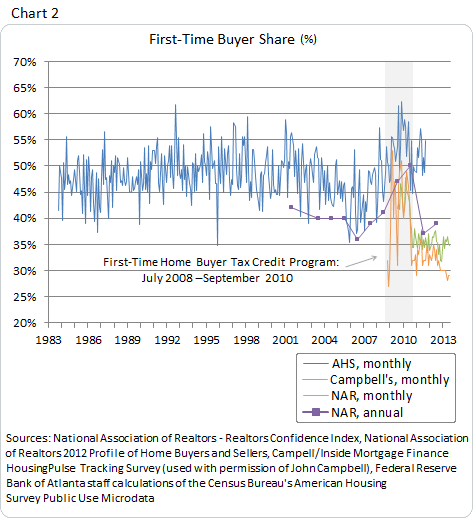It’s become a common trope in housing circles to bemoan the lack of first-time homebuyers in today’s housing market, but are they really lacking?
First-time homebuyers are an essential component to a strong, sustainable housing market. Not only do they serve as a reliable source of demand for new construction properties, but they are also hugely important for move-up homebuyers who are looking sell their smaller homes for bigger, grander things.
Except, according to numerous media reports (us included!), first-time homebuyers have been missing in action, and the housing market has been without one of its most important pieces…or has it? New research from the Federal Reserve Bank of Atlanta is casting doubts on that first-time homebuyer meme, and has come to some fairly contradictory conclusions as well.
Contradicting Methodologies
The researchers for the Atlanta Fed – Jessica Dill, a senior economic research analyst, and Ellyn Terry, an economic policy specialist – began by looking at the two most common sources for the media reports on dwindling first-time homebuyers, and then broadened their research from there:
- Dill and Terry found found that the media reports mainly use findings from the Realtors Confidence Index and the Profile of Home Buyers and Sellers, both of which are compiled by the National Association of Realtors.
- The problem, though, is that the two reports use profoundly different ideologies; the Confidence Index is a monthly survey of roughly 3,500 Realtors, but the Profile is an annual survey of roughly 8,500 households.
- Because of the differing timelines and methodologies, Dill and Terry decided to look at the first-time homebuyer data from a fuller perspective, using multiple data sources to get an idea of the overall trends for the demographic. So, in addition to the NAR data, they also utilized data from the Census Bureau’s American Housing Survey and the Campbell/Inside Mortgage Finance HousingPulse Tracking Survey.
Here’s a graph that Dill and Terry put together, showing their findings:
In case you’re having difficulty deciphering that graph, the gist of their findings is this: the overall trend of first-time homebuyer participation in the housing market is pretty steady across all the respective surveys and indices, even when longer-term analyses, such as the American Housing Survey and NAR’s Profile of Home Buyers and Sellers, are compared with the shorter-term measures of the Campbell/Inside Mortgage Finance series and the Realtors Confidence Index. They all show a steady volume of first-time homebuyers that spikes after 2008 – when the first-time homebuyer tax credit was put into effect – and then falls back to its historic levels. And when the tax credit is excluded, the researchers pointed out, the trend for first-time homebuyer share is flat.
“We do not share the concern,” Dill and Terry wrote, “about weakness in housing demand going forward, because we are not convinced that the data indicates a material decline in first-time buyer participation. Claims of a decline in first-time buyer participation that appear to be based on a comparison of data across different surveys should be treated with caution.”
“In comparing the trends of each series separately,” they continued, “we don’t find there to be much in the way of a material decline in the share of first-time home buyers over the time periods and data series we examined.”
So although it may seem, on the surface, that the number of first-time homebuyers is falling, the true trends of the demographic are much more encouraging.


